Dentistry
At Intake Vets we take a special interest in equine dentistry.
We realize that good dentistry is an important part of your horse’s healthcare and that dental problems are a significant cause of discomfort, pain and poor performance in horses.
A Quick Explanation of the Different Teeth in the Mouth:
The most important teeth in the horse are the molar arcades:
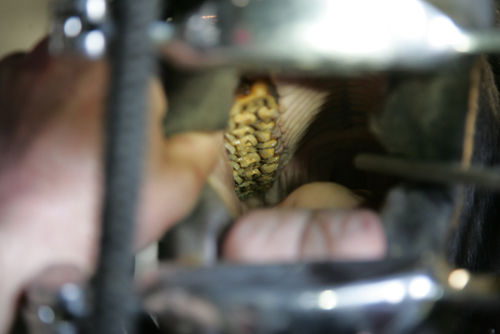
Looking into the mouth, we can see the upper molar arcade. Combined with the lower arcade, these form the opposing walls of teeth that carry out all the chewing and grinding.
The teeth that owners normally look at are the incisors at the front of the mouth:
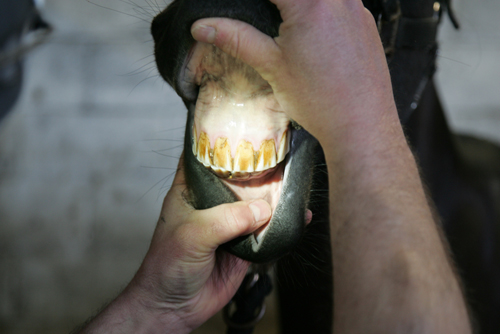
These teeth simply grip grass / forage (and bite!). They are relatively unimportant compared to the molars.
The tushes lie in the gap between the incisors and the molars. They do not occur in all horses. They are the ‘fighting’ teeth but in reality they do little more than collect tartar.
The wolf teeth are small, vestigial teeth just in front of the upper molar arcades. Traditionally they are removed in case they cause a problem with the bit. We are happy to remove them if we think it necessary but many times it is not required.
Why do Horses Need Dentistry?
Horses’ teeth are totally different to ours. In humans, once our adult teeth have erupted, that is it and nothing changes until it is time for dentures. In horses each new molar is several inches long and it continually erupts over the horse’s lifetime. As the horse eats, the grinding surface is gradually worn away and the new tooth moves forward to replace it. No more tooth is formed so eventually the horse ‘runs out’ of tooth.
Because pasture grass is soft, it needs less grinding than the tougher wild grasses that the horse evolved to eat. In addition, commercial feeds are very soft and easy to eat. As a result, the side to side grinding part of the horse’s natural chewing motion is reduced and the sharp edges of the molars are not worn away as they would normally be. Hence the need for routine dentistry.
What Signs Will I See If My Horse Has Dental Pain?
- Weight loss
- General Irritability
- Quidding. (Dropping half chewed balls of food while eating)
- Long fibres in the droppings. If the fibres are significantly longer than in other horses droppings, this indicates poor grinding during chewing
- Packing of the cheeks like a hamster while eating
- Repeated episodes of choke or colic
- Problems with the bit
What Problems Can You Get?
SHARP EDGES
This is a routine problem and easily solved. The first part of a dental is the ‘float’. The sharp edges occur on the outer side of the upper teeth and the inside of the lower arcades. We use a specially designed burr to grind these off accurately:
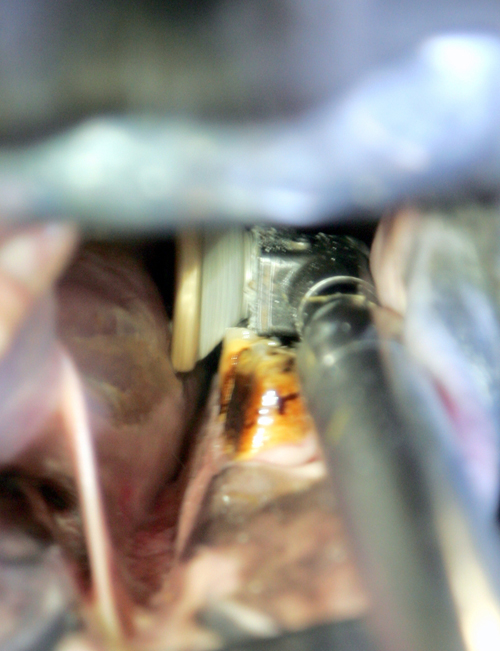
In this picture, you can see the burr rotating at speed - quickly and easily removing the sharp inside edge to the teeth.
HOOKS / OVERGROWTHS / RAMPS / WAVES
Don’t worry about the names. Basically, these are teeth that are out of position from where they should be. We aim to maintain an even grinding surface over the horse’s lifetime. In many horses, minor problems lead to slight misalignments. Over time, these lead to bigger misalignments and eventually major problems occur. Minor adjustments early on prevent the progression.
GUM DISEASE AND ‘DIASTEMA’
The rear grinding teeth should form a continuous ‘wall’ of enamel with barely any gaps between the teeth (see the photo at the top of the page). Unfortunately horses often get pockets forming between individual teeth which allow food to become trapped.
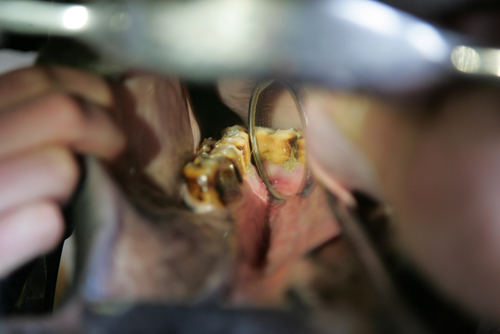
Here, you can see a small amount of grass is trapped between the bases of the two teeth. The trapped food then rots and can set off a gum infection. Gum disease follows, enlarging the pocket and allowing more food to get trapped. A vicious cycle ensues and eventually the roots of the teeth can become exposed. Increasingly this is recognized as one of the leading causes of dental pain and poor chewing. Often a routine float will help with these gaps since it allows the teeth to work in a more natural fashion but sometimes further work is needed. In the worst cases, the pocket is drilled out so that it is larger and shaped so that food does not get jammed in. We can carry out this work.
What Do You Get With an ‘Intake Vets’ Dental?
There are 4 parts to our standard dental:
INCISOR CHECK.
We will check the condition and alignment of the incisors. These will rarely need work but occasionally need slight adjustments. The tushes will be checked for tartar.
THE FLOAT.
The normal sharp edges to the molar arcades are burred off.
ALIGNMENT CHECK AND ADJUSTMENTS.
Any adjustments needed to maintain a good grinding surface are made.
MIRROR CHECK.
This is possibly the most important part of the dental. We use a mirror to carefully check all the teeth and gums right to the back of the mouth.
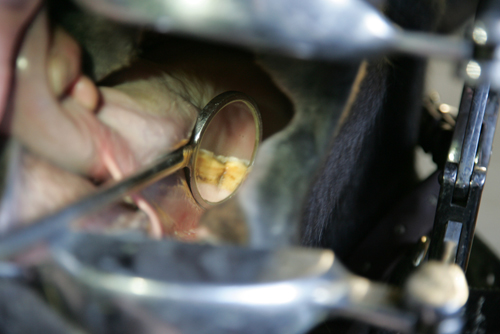
These teeth look good but we are looking for food pocketing and painful gum disease. Very few dentists carry out this essential check - we do. Would you be satisfied if your own dentist did not have a thorough look inside your mouth on your annual check up?
Why do you Sedate Horses for a Dental?
We always sedate horses for dentals. We used motorized equipment which is noisy so there is a safety issue. We prefer to use a headsling rather than a stand (see below), and the horse tolerates this better sedated. However, we sedate primarily to do a good job for you (it is very hard to work accurately on a fidgeting horse) and to make the experience less stressful for the horse. In addition, our dentals are more thorough than most so we tend to be a bit more intrusive. The cost of the sedation is included in the standard dental charge.
The Headsling looks a bit scary!
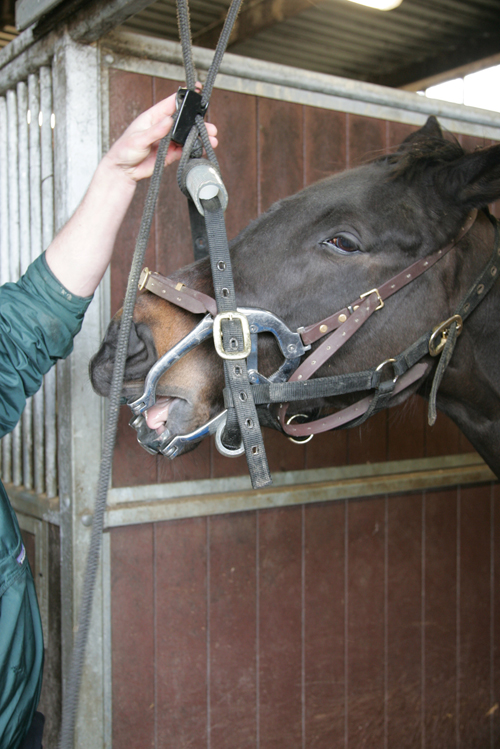
We use the headsling for a number of reasons. It is safe and no one needs to be holding the horses head for ages. It provides a quick, easy adjustment of the horse’s head height and good positioning is critical to doing a thorough dental.
What do we need to get ready for a dental:
- stable with a roof beam or something to attach the headsling to
- Flat work areas are better – sedated horses tend to gravitate downhill!
- A light layer of sawdust or other grippy material is handy in case the horse gets a bit wobbly
- A shaded stable is better – bright sunlight makes it harder to see in the mouth
- A bucket of clean water
How much is a Dental?
A standard dental is £84.00. This includes the sedation. If there are 3 or more horses to do there is no visit charge. If possible, we prefer to do the annual dental at the same time as your horse’s Flu/Tetanus vaccination.
For complex work such as extractions, diastema burring or major arcade adjustments, we would charge on a time basis. We should be able to give you an estimate at the time.
We pride ourselves in offering a thorough, professional dental service. We are a little more expensive than the average dentist but we feel the extra cost is minimal when compared to the annual cost of feed / farriery or livery.
